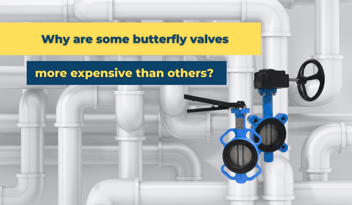What’s the best valve for wastewater and effluent?
In our many years of supplying customers with effective solutions, people have often asked us what type of valve is suitable for effluent and wastewater. Given the variable and corrosive nature of these liquids, and often the presence of debris, it is a crucial decision.
In this article, we outline four common materials used for valves in wastewater and effluent systems. For each, we also provide details on the different configurations available, including pros and cons.
Wastewater and effluent valves
To help you select the most appropriate type of valve for your system, we have collated the main four materials used – cast iron, brass, stainless steel and PVC.
Cast iron valves
Cast iron is known for its excellent castability, machinability, wear resistance and compressive strength. Due to its brittle nature, care should be taken in applications where impact or vibrations are present.
Pros of cast iron:
-
Cost-effective
-
Epoxy coatings provide corrosion-protection
-
Durable
Cons of cast iron:
-
Prone to damage from impact
-
Prone to rust when coatings are damaged
-
Heavy and brittle
1. Cast Iron Butterfly Valves
A butterfly valve consists of a circular disc that rotates within a pipe to open or close the flow. Due to the risk of debris getting trapped around the disc, these are not suited to systems with high fibrous content. However, if you are certain your system contains no debris, this will be an effective solution.
2. Cast Iron Double Door Check Valves
With two hinged doors to control the flow of liquid, a double-door check valve is an effective choice for preventing backflow. They can handle high-pressure, high-volume flows. However, for effluent systems containing a lot of debris, a single-door design will be more suitable as the double doors will create a potential trap point.
3. Cast Iron Single Door Check Valves
A single-door check valve consists of a hinged door designed to open and close, controlling the flow. They have a simple design, prevent backflow and are easy to maintain. They are suitable for wastewater and effluent applications, although in some cases, the size of the bore can be reduced compared to the overall size of the valve which will impact the flow.
4. Cast Iron Ball Type Non-Return Valves
The cast iron ball-type non-return valves are often used in wastewater and effluent applications. When fluid flow is moving, the ball rises into a ‘Y’ junction, completely out of the liquid flow. As the flow stops, the ball returns to its original seat location, preventing liquid backflow. Like the single-door check valves, the ball-type non-return valves provide a clear bore which reduces the chance of debris being trapped. They also have an easy access maintenance port on the ‘Y’ piece of the valve.
Brass valves
Brass is known for its corrosion resistance, machinability and relatively low price. It has low friction, making it suitable for moving parts. While brass valves tend to come at a lower cost, in wastewater and effluent applications you may need to replace them sooner.
Pros of brass:
- DZR valves are corrosion-resistant
- Cost-effective
Cons of brass:
-
Shorter lifespan in wastewater and effluent applications
1. Brass Gate Valves
With excellent flow control and an open bore, this valve consists of a gate that is raised and lowered as required. Unfortunately, debris can build up, preventing full closure and causing leaks. Over time, brass is likely to corrode, requiring replacement much sooner than other materials.
2. Brass Ball Valves
Ball valves contain a globe, known as a ball, that is rotated to open or close the flow. Control is much finer, and the open bore means there is little resistance. When used in an effluent system, debris can build up, wear out the parts, and cause leaks and difficult operation over time.
3. Brass Spring Check Valve
A spring check valve consists of a spring-loaded disc that is pressed against the opening by a spring. When fluid flow is moving in the correct direction, the spring compresses and the disc moves away from the opening. When fluid flow stops, the spring compression releases, forcing the disc back to its seat and preventing backflow. These are more suited to clean water systems than wastewater and effluent systems. Additionally, be aware that these valves don’t have a completely clear bore which will likely create a trap point for slurries and debris.
4. BRASS SWING CHECK VALVE
Consisting of a disc or gate that swings on a hinge to open and close, a swing check valve prevents backflow. When fully open it has a relatively clear bore, allowing liquid to flow freely with less risk of debris being trapped. Typically, these are more suited to low-pressure waste disposal systems with minimal solids content.
Stainless steel valves
Due to the chromium content, stainless steel has high corrosion resistance. It is known for its durability, strength and low maintenance.
Pros of stainless steel:
-
Corrosion-resistant
-
Longer lifespan
-
Durability
-
Can withstand high temperatures
Cons of stainless steel:
-
Typically higher upfront cost
-
Not suited to high concentrations of certain chemicals which may be present in some wastewater applications
1. Stainless Steel Knife Gate Valve
A stainless steel knife gate valve is designed to control the flow of liquids. It is characterised by a sharp-edged gate or ‘knife’ that moves up and down as required. Some of the most notable advantages are corrosion resistance to most wastewater and effluent, its durability resulting in a longer lifespan, and lower maintenance costs. While they typically cost more, better incremental control, an open bore and a longer life expectancy will be worthwhile for many applications.
2. Stainless steel butterfly valves
Just like the cast iron version, a stainless steel butterfly valve contains a circular disc that rotates to open or close the pipe. Unfortunately, they are susceptible to trapping debris and are not suitable for systems containing high-fibre liquids.
PVC Valves
Made from polyvinyl chloride plastic, PVC is known for its durability, chemical resistance and low cost.
Pros of PVC:
-
Corrosion resistance
-
Chemical resistance
-
Durability
-
Low cost
Cons of PVC:
-
Brittle when exposed to high UV
-
Prone to breakage under shock or vibration
1. PVC Slide Valve
A PVC slide valve contains a sliding gate that moves vertically. There are different types of PVC slide valves; 1. Fully enclosed body, and 2. A one-piece slide option which generally has an open top. In a pressurised application, liquid could force its way out of the top of the one-piece slide option, making them better suited to applications with no pressure against the valve (such as a stormwater diversion system). It is best to use a fully sealed option for other low-pressure applications. The advantage of a one-piece design is the ability to clean inside and maintain easier operation.
2. PVC Ball Valves
PVC ball valves contain a globe, known as a ball, that is rotated to block the flow of fluids. When open, there is a clear bore where liquid can flow freely. With a double union design, you can easily disconnect it for maintenance and cleaning.
Conclusion
When it comes to maintaining a safe and efficient wastewater and effluent system, your choice of valves is vital. For more advice, recommendations, and industry expertise, contact the Waterworks team today.
Want to ensure the smooth and efficient operation of your system? Browse our range for the perfect product for your needs.

.png)


-1.png?width=352&name=WW%20%20Blog%20headers%202023%20(3)-1.png)
